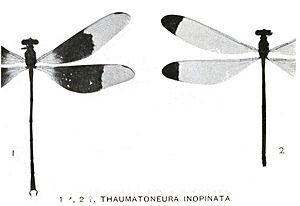Thaumatoneura inopinata facts for kids
Quick facts for kids Thaumatoneura inopinata |
|
|---|---|
 |
|
| Conservation status | |
| Scientific classification | |
| Genus: |
Thaumatoneura
|
| Species: |
inopinata
|
The Thaumatoneura inopinata is a special kind of damselfly. People sometimes call it the cascade damselfly or giant waterfall damsel. It is the only species in its group, called Thaumatoneura. This damselfly is amazing because it flies right among the falling water and spray of waterfalls. You can find it in warm, wet forests in Costa Rica.
Contents
Meet the Giant Waterfall Damsel
This damselfly is very unique. Scientists have placed it in its own special group, called a monotypic genus and subfamily. This means it's the only one of its kind in those categories.
For a while, scientists thought it belonged to the flatwing damselfly family. But in 2013, new studies looked at its DNA. These studies showed that Thaumatoneura actually belongs to a different family called Thaumatoneuridae.
An English insect scientist, Robert McLachlan, first described this damselfly in 1897. He bought a specimen but didn't know where it came from. Later, another one was found in Panama, showing it was from the New World.
Another American insect scientist, Philip Powell Calvert, traveled to Costa Rica to study it. He saw adult damselflies near waterfalls. He also found young damselflies, called nymphs, on wet rocks with plants. It took some time to be sure the nymphs and adults were the same species. Finally, a nymph was seen turning into an adult. As the insect's body fluid, called haemolymph, filled its wings, they looked pale green with dark veins. With its green body, the damselfly looked just like a trembling green leaf, helping it hide among the plants.
Where Does It Live?
The giant waterfall damsel lives in Costa Rica and Panama. Its natural habitat is in warm, wet montane forests and near rivers. You will almost always find it very close to waterfalls.
How Does It Look?
Male giant waterfall damselflies come in two forms. Some have wings that are completely clear. Others have wide black bands across their wings. Female damselflies have clear wings with brown tips.
In both males and females, there's a special notch on the front edge of each wing, called a nodus. This nodus is closer to the base of the wing than in most other damselfly species. When the damselfly rests, it holds its wings straight up over its body. This helps water drip off its wings.
Its Amazing Life Cycle
The giant waterfall damsel loves to fly through the falling water and spray of waterfalls. The female lays her eggs among the moss and tangled roots next to the waterfall. These spots are always kept wet by the water.
The young nymphs grow up in this wet plant life. They usually do not go into the fast-moving water. When they are fully grown and ready to become adults, they climb onto a rock. Their skin splits open, and the adult damselfly, with its new wings, climbs out.
Is It Safe?
The International Union for Conservation of Nature (IUCN) is a group that checks on how safe different animal species are. This group used to say the giant waterfall damsel was "threatened" (meaning it was at risk).
However, scientists have recently found this damselfly in more places in Costa Rica. Even though it's not super common, there are now enough of them. So, the IUCN now classifies it as "least concern" (meaning it's not currently at high risk).
The main dangers it faces are deforestation, which changes its stream homes. Also, global warming could make some streams and waterfalls dry up.


